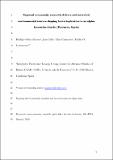Por favor, use este identificador para citar o enlazar a este item:
http://hdl.handle.net/10261/195847COMPARTIR / EXPORTAR:
 SHARE
BASE SHARE
BASE
|
|
| Visualizar otros formatos: MARC | Dublin Core | RDF | ORE | MODS | METS | DIDL | DATACITE | |

| Campo DC | Valor | Lengua/Idioma |
|---|---|---|
| dc.contributor.author | Ortiz-Álvarez, Rüdiger | es_ES |
| dc.contributor.author | Caliz, Joan | es_ES |
| dc.contributor.author | Camarero, Lluís | es_ES |
| dc.contributor.author | Casamayor, Emilio O. | es_ES |
| dc.date.accessioned | 2019-12-03T07:28:22Z | - |
| dc.date.available | 2019-12-03T07:28:22Z | - |
| dc.date.issued | 2019 | - |
| dc.identifier.citation | Environmental Microbiology : doi:10.1111/1462-2920.14848 (2019) | es_ES |
| dc.identifier.issn | 1462-2912 | - |
| dc.identifier.uri | http://hdl.handle.net/10261/195847 | - |
| dc.description | Este artículo contiene 13 páginas, 2 tablas, 6 figuras. | es_ES |
| dc.description.abstract | Microbial communities in natural ecosystems are subjectto strong ecological rules.The study of local communi-ties along a regional metacommunity can reveal patternsof community assembly, and disentangle the underlyingecological processes. In particular, we seek drivers ofcommunity assembly at the regional scale using a largelacustrine dataset (>300 lakes)along the geographical,limnological and physico-chemical gradients in the Pyre-nees. By using high throughput amplicon sequencing ofthe 16S rRNA gene, and inferring environmental sourcesof bacterial immigrants, we showed that surface aquaticbacterial assemblages were strongly influenced by ter-restrial populations from soil, biofilms or sediments, andprimarily selected by a pH-alkalinity gradient. Indeed,source proportions explained 27% of the community vari-ation, and chemistry 15% of the total variation, half of itshared with the sources. Major taxonomic groups suchas Verrucomicrobia, Actinobacteria and Bacteroidetesshowed higher aquatic affinities than Parcubacteria,Gammaproteobacteria, Alphaproteobacteria or Betapro-teobacteria, which may be recruited and selected throughdifferent hydrographic habitats. A regionalfingerprintwas observed with lower alphadiversity and higher betadiversity in the central Pyrenees than in both ends. Wesuggest an ecological succession process, likelyinfluenced by complex interactions of environmentalsource dispersal and environmentalfiltering along themountain range geography. | es_ES |
| dc.description.sponsorship | This research was funded by Grants BRIDGESCGL2015–69043-P from the Spanish Office of Science(MINECO) and European funding (ERDF) and DISPERSAL(Ref. 829/2013) from the Spanish National Parks research pro-gram (OAPN-MAGRAMA), to EOC. We thank technicians andstudents who participated in thefield sampling expeditions.ROA was supported by the FPI fellowship programme from theSpanish Government for project DARKNESS CGL2012-32747to EOC. | es_ES |
| dc.language.iso | eng | es_ES |
| dc.publisher | John Wiley & Sons | es_ES |
| dc.relation.isversionof | Post-print | - |
| dc.rights | openAccess | es_ES |
| dc.title | Regional community assembly drivers and microbialenvironmental sources shaping bacterioplankton in analpine lacustrine district (Pyrenees, Spain) | es_ES |
| dc.type | artículo | es_ES |
| dc.description.peerreviewed | Peer reviewed | es_ES |
| dc.relation.publisherversion | https://doi.org/10.1111/1462-2920.14848 | es_ES |
| dc.identifier.e-issn | 1462-2920 | - |
| dc.relation.csic | Sí | es_ES |
| oprm.item.hasRevision | no ko 0 false | * |
| dc.type.coar | http://purl.org/coar/resource_type/c_6501 | es_ES |
| item.openairetype | artículo | - |
| item.grantfulltext | open | - |
| item.cerifentitytype | Publications | - |
| item.openairecristype | http://purl.org/coar/resource_type/c_18cf | - |
| item.fulltext | With Fulltext | - |
| item.languageiso639-1 | en | - |
| Aparece en las colecciones: | (CEAB) Artículos | |
Ficheros en este ítem:
| Fichero | Descripción | Tamaño | Formato | |
|---|---|---|---|---|
| Ortiz et al_post-print.pdf | 3,77 MB | Adobe PDF |  Visualizar/Abrir |
CORE Recommender
Page view(s)
245
checked on 18-abr-2024
Download(s)
227
checked on 18-abr-2024
Google ScholarTM
Check
NOTA: Los ítems de Digital.CSIC están protegidos por copyright, con todos los derechos reservados, a menos que se indique lo contrario.
